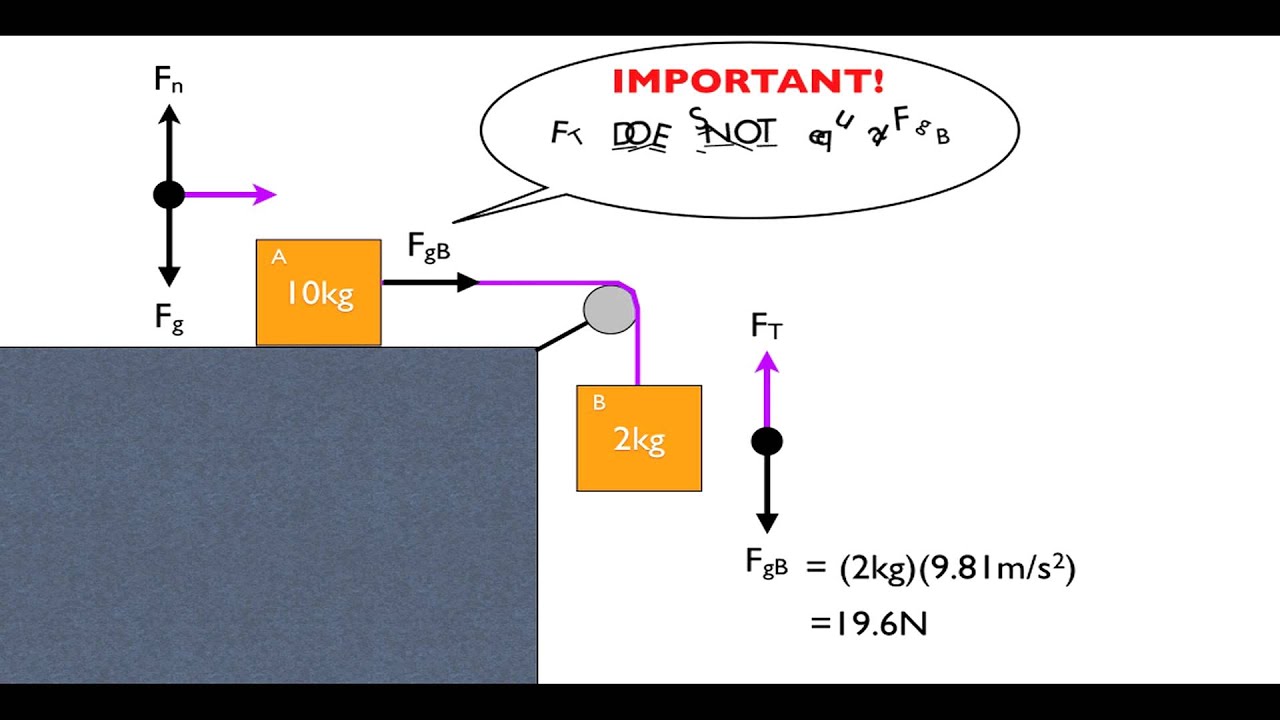for a mass pulled up an incline via a pulley
Example
A 2 kg mass on a smooth 30o plane is connected to a 5 kg mass by a light inextensible string passing over a pulley at the top of the plane.
When the particles are released from rest the 2 kg mass moves up the plane.
i) what is the acceleration of the 2 kg & 5 kg masses?
ii) What is the tension in the string?
i)
ii)
Mass ascending or descending in a lift
it is important to remember that there are only two forces on the body in the lift - the weight down and the reaction of the floor up.
Example
A person of mass 100 kg stands in a lift.
What is the force exerted by the lift floor on the person when the lift is:
i) moving upwards at 3 ms-1
ii) moving downwards at 4 ms-1
i)
ii)
Draw all the forces which affect the bucket and the block in the picture. Write the force equations for them.
Forces that affect the bucket m2:
(vec{F}_{G_2})…weight
(vec{T})…tension force by which the rope affects the bucket
Forces that affect the block m1:
(vec{F}_{G_1})…weight
(vec{T}prime)…tension force by which the rope affects the block
(vec{T}primeprime)…tension force by which the rope affects the block
The vector force equation for the bucket:
[vec{F}_{G2}+vec{T}=m_2vec{a}_2tag{1}]
The vector force equation for the block:
[vec{F}_{G1}+vec{T}prime+vec{T}primeprime=m_1vec{a_1}tag{2}]
We choose the y-axis the way it is marked on the picture.
We rewrite equations (1) and (2) to scalar form:
[T-F_{G2}= m_2a_2tag{3}]
[F_{G1}-Tprime-Tprimeprime = m_1a_1tag{4}]
Because we leave the mass of the pulley system and the rope out of account they have no moment of inertia and don’t affect the tension forces. The following holds for the magnitude of the tension forces:
[|vec{T}|=|vec{T}prime|=|vec{T}primeprime|]
We rewrite equations (3) and (4):
[T-F_{G2}= m_2a_2tag{5}]
[F_{G1}-2T= m_1a_1tag{6}]
Relation between the magnitudes of acceleration a1 and a2:
If the bucket goes up a distance s, the block goes down a distance (frac{s}{2}).
[s=frac{1}{2}a_2t^2]
[frac{s}{2}=frac{1}{2}a_1t^2]
We divide the first equation by the second equation, yielding:
[2=frac{a_2}{a_1}]
[a_2=2a_1tag{7}]
Equation (5) and equation (6) can be written as:
[T-m_2g= m_22a_1tag{8}]
[m_1g-2T= m_1a_1tag{9}]
We have two equations (8) and (9) in two variables T and a1. From them we can determine the magnitude of the acceleration a1 and the force T. We multiply equation (8) by 2 and add both equations up:
[m_1g-2m_2g= m_1a_1+4m_2a_1]
[(m_1-2m_2)g= (m_1+4m_2)a_1]
[a_1=frac{(m_1-2m_2)g}{m_1+4m_2}tag{10}]
According to equation (7):
[a_2=2a_1=2frac{(m_1-2m_2)g}{m_1+4m_2}=frac{(2m_1-4m_2)g}{m_1+4m_2}tag{11}]
The magnitude of the tension force T is given for example by equation (8):
[T-m_{2g}= m_22a_1]
[T=m_22a_1+m_{2g}=m_2frac{2(m_1-2m_2)g}{m_1+4m_2}+m_2g]
[T=frac{2(m_2m_1-2m_2^2)g}{m_1+4m_2}+m_2g =frac{(2m_2m_1-4m_2^2+m_2(m_1+4m_2))g}{m_1+4m_2}]
[T=frac{(2m_2m_1-4m_2^2+m_2m_1+4m_2^2)g}{m_1+4m_2}= frac{3m_2m_1g}{m_1+4m_2}]
[T=frac{3m_2m_1g}{m_1+4m_2}tag{12}]

